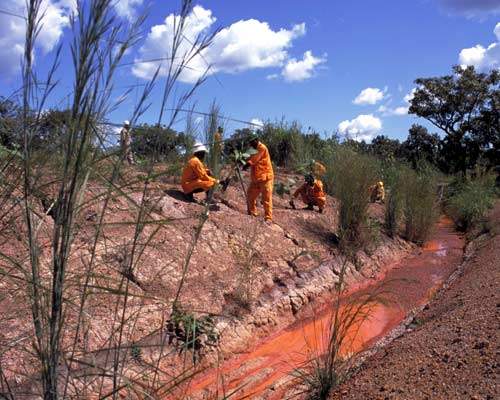The Siguiri gold mine is found within the Siguiri District in the north-east of the Republic of Guinea, West Africa, 850km from the capital city of Conakry. The nearest important town is Siguiri (approximately 50,000 inhabitants), located on the banks of the Niger River. Bamako, the capital of Mali is 300km away.
A majority stake in the mine (85%) was bought by Ashanti Goldfields in 1996 and became a part of AngloGold Ashanti when the two companies merged in 2004. The government of The Republic of Guinea holds a 15% interest in the mine. The first shipment of gold from Siguiri took place in April 1998.
The Siguiri mine produced 213,000oz in 2019 and 242,000oz in 2018. The decline in production was primarily due to lower plant feed grade and recovery.
Around 3,056 employees and contractors work at the Siguiri mine. Total capital expenditure on the project for 2019 was $19m.
The gold mine is located in the heart of an ancient gold mining region, which is thought to have been known since the 13th century as the basis of the Mandingo Empire. At its peak this empire controlled an area in West Africa the size of the US.
Unlike in many other areas in Africa, the orpaillage (translated as gold-washing), or artisanal mining system is highly formalised and forms an integral part of village structures.
However, there have been numerous clashes between the miner AngloGold Ashanti and some groups of artisanal miners who have been found operating beyond the traditional orpaillage system and, therefore, agreed areas. On some occasions, mainly during the rainy season, as many as 10,000 people have been involved in pit invasions when artisanal workings are flooded or inaccessible. AngloGold recently announced that it had engaged the services of a specialist consultancy to assist with future disputes.
Leading gold producer Barrick Gold had a royalty entitlement of 1.875% on the Siguiri mine, capped on a dollar basis and with $15m still being paid. This entitlement was sold in June 2008 to precious metals Royalty company Royal Gold as part of a portfolio of Barrick assets valued at $150m.
Geology and reserves
This concession is dominated by Proterozoic Birmian rocks which consist of turbidite facies sedimentary sequences. There are essentially two kinds of gold deposit that occur in the Siguiri basin: laterite or CAP mineralisation and in situ quartz vein-related mineralisation. The first appears as aprons of colluvial or as palaeo-channels of alluvial lateritic gravel adjacent to, and directly above, the latter.
The quartz vein-related mineralisation is hosted in meta-sediments with the better mineralisation associated with vein stockworks that occur preferentially in the coarser, brittle siltstones and sandstones. The mineralised rocks have been deeply weathered to below 100m in places to form saprolite or SAP mineralisation.
As of December 2019, the total ore reserves in the proven and probable category at Siguiri were estimated to be 72.33Mt graded 0.76g/t, containing 1.76Moz of gold. The mineral resources (measured, indicated and inferred) stood at 185.6Mt graded 0.95g/t with contained gold of 5.7Moz.
Mining and processing at Siguiri Gold Mine
The ore and waste are mined by a mining contractor in a conventional open-pit mining operation. Ore was earlier treated using carbon-in-pulp (CIP) and heap-leach processes. In 2009, the CIP plant increased volumes to 10.4Mt.
A total of 74,939m was drilled at the Siguiri mine and 8.8Mt of gold was mined during 2019.
The CIP was converted into a hybrid carbon-in-leach (CIL) circuit processing plant in 2018.
The original processing plant was capable of processing soft ore alone. It was optimised to increase the capacity to 11.8Mtpa. The new CIL plant achieved the capability to treat 50% hard ore following the commissioning of a new ball mill and three-stage crushing plant in the first quarter of 2019.
The existing mining concession is valid until 4 August 2022, with a high possibility of extension until 2041.
Production
The Boure area, where Siguiri’s current mining activity is focused, is home to around 40,000 people in 12 villages – Kintinian, Boukaria, Balato, Fatoya, Kofilani, Samany, Kourouni, Kamatiguiya, Setiguiya, Kourouda, Lenkekoe and Fenserekolen – all within the sub-prefecture of Kintinian.
Further exploration here and at nearby Sintroco saw a further 1.3Moz converted to reserves. The design of a second gravity concentrator and de-gritting facilities was finalised and installed during 2009, with improved productivity expected. Studies to increase throughput were commissioned in 2010.
The production from the mine in 2019 accounted for 14% of the production in the region.
Contractors involved
Wärtsilä won a contract to supply a power plant extension to the gold mine in June 2017. The contract involved the connection of three 20-cylinder Wärtsilä 32TS engines to the existing power plant, which was previously supplied by Wärtsilä. AngloGold Ashanti selected Aurecon as owner’s engineer for the 30MW power plant at the mine.
SRK Consulting was contracted to conduct environmental, health, and socio-economic baseline studies for block two at the Siguiri mine.









